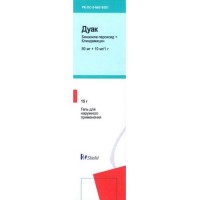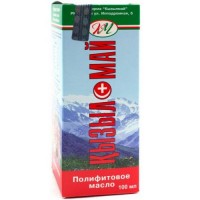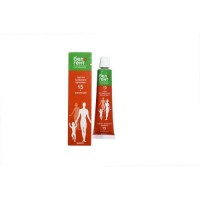Klobeford 0.5 mg / g 30g Cream for external use in a tube
- $13.40
The instruction for medical use of medicine Klobeford the Trade name Klobeford the International unlicensed name Klobetazol Lekarstvennaya a form external use Cream, 30 g Structure of 1 g of cream contains active agent - a klobetazol of propionate of 0.50 mg, excipients: a macrogoal cetostearyl ether, cetostearyl alcohol, methylparahydroxybenzoate, propyl-parahydroxybenzoate, paraffin white soft (white vaseline), chlorcresol, propylene glycol, dihydrophosphate sodium a dihydrate, the water purified. Description Uniform cream of white color Pharmacotherapeutic Dermatology group. Corticosteroids, dermatological drugs. Glucocorticosteroids, simple. Glucocorticosteroids very significant activity (group IV). Klobetazol. ATH D07AD01 code the Pharmacological Pharmacokinetics At properties topical administration of drug, especially during the using of an occlusive bandage or injuries of skin, absorption of a klobetazol of propionate with development of system side effects of glucocorticoids is possible. Klobetazola propionate has smaller ability to contact proteins of plasma in comparison with a hydrocortisone, but big elimination half-life. The rest – kidneys is metabolized, mainly, by a liver. It is removed with urine. A pharmacodynamics the action Mechanism Anti-inflammatory action of corticosteroids for external use is caused by many factors thanks to which there is an inhibition of a late phase of allergic reactions, including decrease in density of mastocytes, reduction of a chemotaxis and activation of eosinophils, reduction of production of cytokines lymphocytes, monocytes, mastocytes and eosinophils and inhibition of metabolism of arachidonic acid. Pharmakodinamichesky effects Corticosteroids for external use render anti-inflammatory, antipruritic and vasoconstrictive effects. Drug causes vasoconstriction and decrease in synthesis of collagen. Eliminates hypostasis, hyperaemia and an itching in the site of application. Indications Klobeford is applied to short-term treatment of more resistant forms of a dermatosis, such as: - psoriasis (except for widespread blyashechny psoriasis) - the refractory forms of a dermatosis (which are difficult responding to treatment) - red flat deprive - a diskoidny lupus erythematosus - other skin diseases resistant to therapy of less active glucocorticoids the Route of administration and doses the Dosage and a method of introduction Klobeford are recommended to be used for treatment of the damp and becoming wet sites of skin. Klobeford it is necessary to use one or twice a day. Treatment should be continued for improvement, no more than 4 weeks, and then to reduce use or use of a product with smaller effect. Cream is applied with a thin layer in the quantity sufficient for a covering of all struck area, one or twice a day, and carefully rubbed before improvements (in case of more serious conditions the use can continue within several days), then it is recommended to reduce the frequency of drawing or to switch to less active drug. After each putting drug before use of any other emollient it is necessary to allow cream to be absorbed. As well as at use of other highly active glucocorticosteroids (GKS), after achievement of control over a disease the treatment should be stopped. Improvement in the treatment outcome occurs individually, at patients who well perceive treatment, the result can appear in several days. For prevention of exacerbation of a disease it is possible to conduct repeated short courses of treatment of a klobetazol propionate. At treatment of resistant diseases, especially in a hyperkeratosis, the efficiency of the dermovat can be increased at the expense of an occlusive bandage (for example, a polyethylene film). As a rule, use of an occlusive bandage only for the night brings noticeable improvement which can be supported, using a medicinal product without occlusive bandage. If improvement of a state did not occur within 2 - 4 weeks, it is necessary to specify or revise the diagnosis. If long-term treatment is required, it is necessary to use other, less strong drugs. Treatment klobetazoly should be cancelled gradually, at once after achievement of control over a disease, and use of any other emollient has to be continued as maintenance therapy. The maximum week dose should not exceed 50 g a week. Atopic dermatitis. During treatment of atopic dermatitis, after improvement, use of the dermovat should be stopped gradually, and emollient is used as the supporting treatment. Sudden cancellation of a klobetazol can lead to a recurrence of earlier being available dermatosis. Patients with a frequent recurrence of a disease As soon as the effect of treatment of an acute disease, thanks to a continuous course of use of corticosteroids for external use will be reached, the possibility of its faltering use can be considered (once a day, two times a week, without occlusive bandage). It is known that such treatment effectively reduces the frequency of development of a recurrence. It is necessary to continue putting drug on all earlier affected areas of skin or on the known areas of potential aggravation. Such scheme of use has to be combined with regular daily use of any, other emollient. It is necessary to carry out the regular assessment of a state and also advantage and risk of treatment continuation. Children Klobeford is contraindicated to children aged up to 18 years. Children have higher risk of local and system effects of local corticosteroids. Besides, shorter duration of treatment and use of corticosteroids with lower efficiency, than usually usually is required. It is necessary to show care during treatment by Klobeford and to use it in minimum possible degree for ensuring therapeutic effect. Elderly patients Clinical trials did not reveal any differences in efficiency of drug at elderly and younger patients. The big prevalence of reduced function of a liver or kidneys at patients of advanced age can lead to delay of removal of drug in case of its system absorption. Therefore, it has to be applied in the minimum quantity and during the minimum possible period to achievement of necessary clinical effect. A renal failure / liver in case of system absorption of drug (when drawing on the extensive surfaces of skin during the long period) his metabolism and removal can slow down, resulting in the increased risk of development of system toxicity. Therefore, it has to be applied in the minimum quantity and during the minimum possible period to achievement of necessary clinical effect. Patients are recommended to wash hands after use of a klobetazol of propionate if only drug is not intended for treatment of hands. Side effects the Undesirable phenomena are listed below depending on a system and organ class and frequency of occurrence. Frequency of occurrence is defined as follows: very often (≥1/10), it is frequent (≥1/100 and & lt, 1/10), infrequently (≥1/1,000 and & lt, 1/100), is rare (≥1/10,000 and & lt, 1/1,000) and is very rare (& lt, 1/10,000), including separate cases. Data of post-marketing use Infectious and parasitic diseases Very seldom - opportunistic infections of Disturbance from the immune system Very seldom - hypersensitivity - generalized rash of Disturbance from an endocrine system Very seldom - oppression gipotalamo - a hypophysial and adrenal system – signs of the Cushingoid or a hypercorticoidism: (for example, a crescent-shaped face, obesity on the central type), an increase delay a body weight / growth inhibition at children, osteoporosis, glaucoma, a hyperglycemia/glucosuria, a cataract, a hypertension, increase in weight body/obesity, decrease in levels of endogenous cortisol, an alopecia, fragility of hair. Disturbances from skin and hypodermic fabrics Often - an itching, the local burning sensation / skin soreness Infrequently - a local atrophy of skin * - striya * - teleangiectasias * Is very rare - thinning of skin * (at long and intensive treatment) - rugosity of skin *, xeroderma * - pigmentation change *, a hypertrichosis - aggravation of symptoms of a disease - dermatitis - pustulous psoriasis - an erythema, rash, an itching, urticaria, allergic contact dermatitis / dermatitis - the acne (acne rash) At emergence of signs of hypersensitivity use of drug should be stopped. Long-term and intensive treatment by highly active GKS can cause atrophic changes, such as striya and thinning of skin. In rare instances treatment of psoriasis of GKS (or its termination) can provoke a pustulous form of a disease. Long-term and intensive treatment by highly active GKS can lead to expansion of superficial blood vessels, especially during the using of hermetic bandages or rubbing in of drug in skin folds. Complications of the general character and reaction in the site of application It is very rare - the irritation and/or morbidity in the site of application * Skin manifestations are secondary in relation to local and/or system effects of oppression gipotalamo - a hypophysial and adrenal system. The reporting on expected side reactions the Reporting on expected side reactions of drug is the important point allowing to carry out continuous monitoring of a ratio risk/advantage of medicine. Health workers should provide information on any expected adverse reactions on the contacts specified at the end of the instruction and also through national reporting system. Contraindications - hypersensitivity to active agent or any auxiliary component of drug - not treated infections of skin - the damages of skin caused by viruses (virus of a herpes simplex, chicken pox) - eels ordinary (youthful eels) - a rozatsea (pink eels) - a skin itching in the absence of inflammation - perioral dermatitis - a perianal and genital itching - children's and teenage age up to 18 years (there are no data on safety and efficiency) it is not necessary to use drug outwardly for treatment of primary skin damages caused fungal (for example, candidiasis, a trichophytia) or bacterial (for example, impetigo) an infection. Medicinal interactions of the Research on interactions were not carried out. Special instructions Klobetazol should be applied with care at patients with existence in the anamnesis of local hypersensitivity to other corticosteroids or to any of excipients as a part of drug. Local reactions of hypersensitivity can have similarity to symptoms of the proceeding disease. Klobeford cream contains propylene glycol which can cause irritation of skin, cytostearyl alcohol which can cause local, skin reactions (including contact dermatitis), chlorocresol which can cause allergic reactions. Some persons as a result of the increased system absorption of local steroids can have manifestations of a hypercorticoidism (Cushing's syndrome) and reversible oppression gipotalamo - a hypophysial and adrenal system, leading to glucocorticosteroid insufficiency. In case of any of the above-stated manifestations, drug should be cancelled, gradually reducing the frequency of its drawing, or to replace it with less active corticosteroid. The sudden termination of treatment can lead to development of glucocorticosteroid insufficiency. The following belongs to risk factors of strengthening of system effects: - activity and a dosage form of topical steroid - use duration - putting drug on extensive sites of skin - use on the closed areas of skin (i.e. in intertriginozny zones or under occlusive bandages) - the increased hydration of a corneal layer of skin - use in areas with thin skin, such as person - drawing on the injured skin or at other states which can be followed by disturbance of integrity of a skin barrier - in comparison with adults at children can be noted bigger percent of absorption of corticosteroids for external use in this connection this category of patients is more subject to risk of development of system side effects. It is caused by the fact that children have an unripe skin barrier and bigger value of the relation of surface area of a body to body weight in comparison with adults. Risk of developing an infection at use of occlusive bandages the Warm damp conditions in skin folds and also created when imposing an occlusive bandage promote developing of a bacterial infection. Therefore when using occlusive bandages before imposing of a new bandage it is necessary to clean skin carefully. Use in psoriasis For treatment of psoriasis corticosteroids for external use should be used with care since it was in certain cases reported about resuming of symptoms of a disease, development of stability to drug, risk of a generalized pustulous form of psoriasis and development of local or general toxicity because of disturbance of barrier function of skin. At treatment of psoriasis the attentive observation of the patient is important. The accompanying infection At accession of consecutive infection it is necessary to carry out the corresponding antibacterial therapy. At any signs of spread of an infection it is necessary to stop use of corticosteroids for external use and to carry out the corresponding treatment by antibacterial drugs. Before use of hermetic bandages it is necessary to clean skin as heat and humidity which are formed under a bandage promote developing of a bacterial infection. Chronic ulcers of shins Corticosteroids for external use are sometimes used for treatment of the dermatitis arising around chronic ulcers of shins. However such use can be followed the hypersensitivity increased by the frequency of emergence of local reactions and the increased risk of developing local infections. Drawing on the person Drawing on face skin is undesirable since this area is more subject to development of atrophic changes. In case of drawing on face skin the treatment should be limited for 5 days. Drawing on eyelids Putting drug on eyelids is undesirable. When drawing on eyelids it is necessary to watch that drug did not get into eyes because repeated influence of drug can cause a cataract and glaucoma. At hit of drug in eyes, it is necessary to wash out a large amount of water. Fertility of the corticosteroids Given about influence for external use on reproductive function there are no people. Pregnancy Data on use of a klobetazol at pregnant women are limited. Topical administration of corticosteroids can cause anomalies of fetation in pregnant animals, including sky crevices (wolf mouth), a delay of pre-natal development. The value of these results for people is not defined. Klobetazol it is necessary to apply during pregnancy only if the potential advantage for mother exceeds risk for a fruit. It is necessary to use the minimum quantity during minimum possible period. The lactation period Safety of use of corticosteroids for external use in the period of a lactation is not established. It is unknown whether leads topical administration of corticosteroids to sufficient system absorption for discharge of noticeable quantity with maternal milk. Klobetazol it is necessary to apply during breastfeeding only if the potential advantage for mother exceeds risk for the baby. If klobetazol it is used during a lactation, it should not be applied on area of a breast in order to avoid accidental ingestion by the baby. Features of influence of medicine on ability to run the vehicle or potentially dangerous mechanisms of Researches on studying influence of a klobetazol on ability to run vehicles or to work with mechanisms it was not carried out. Proceeding from a profile of side reactions of a klobetazol for external use, any adverse influence on such types of activity it is not expected. The overdose Symptoms Klobetazol can cause system effects at absorption in enough. Emergence of acute overdose is improbable, however in case of chronic overdose or the wrong use there can be signs of a hypercorticoidism that demands drug withdrawal. Treatment In a sluch
of overdose klobetazol it has to be cancelled gradually, reducing the frequency of use or by replacement with less strong corticosteroid, in connection with risk of development of glucocorticosteroid insufficiency. The form of release and packing On 30 g place in tubas aluminum with internal varnish coating, sealed by membranes and closed by the screwing plastic cover. On 1 tuba together with the instruction for medical use in the state and Russian languages place in a pack from cardboard. To Store storage conditions in the place protected from light at a temperature not above 25 °C. To store out of children's reach! 3 years not to apply a period of storage after an expiration date. Prescription status According to the prescription the Name and the country of the manufacturing organization Oxford Laboratories Pvt. Ltd, B 306, Christal Plaza, New Link Road, Andheri (Vest), Mumbai, India the Producer/packer Oxford Laboratories Pvt. Ltd, India the Holder of the registration certificate Oxford Laboratories Pvt. Ltd, India the Name, the address and a contact information (phone, the fax, e-mail) of the organization in the territory of the Republic of Kazakhstan accepting claims (offer) on quality of medicines from consumers, responsible for post-registration observation of safety of TOO ConsultAsia Shevchenko St. medicine of 165 B ph./fax: +77051708876/+77051708825 e-mail:
To Develop pv@consultingasia.kz
of overdose klobetazol it has to be cancelled gradually, reducing the frequency of use or by replacement with less strong corticosteroid, in connection with risk of development of glucocorticosteroid insufficiency. The form of release and packing On 30 g place in tubas aluminum with internal varnish coating, sealed by membranes and closed by the screwing plastic cover. On 1 tuba together with the instruction for medical use in the state and Russian languages place in a pack from cardboard. To Store storage conditions in the place protected from light at a temperature not above 25 °C. To store out of children's reach! 3 years not to apply a period of storage after an expiration date. Prescription status According to the prescription the Name and the country of the manufacturing organization Oxford Laboratories Pvt. Ltd, B 306, Christal Plaza, New Link Road, Andheri (Vest), Mumbai, India the Producer/packer Oxford Laboratories Pvt. Ltd, India the Holder of the registration certificate Oxford Laboratories Pvt. Ltd, India the Name, the address and a contact information (phone, the fax, e-mail) of the organization in the territory of the Republic of Kazakhstan accepting claims (offer) on quality of medicines from consumers, responsible for post-registration observation of safety of TOO ConsultAsia Shevchenko St. medicine of 165 B ph./fax: +77051708876/+77051708825 e-mail:
To Develop pv@consultingasia.kz








